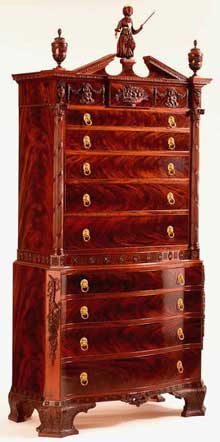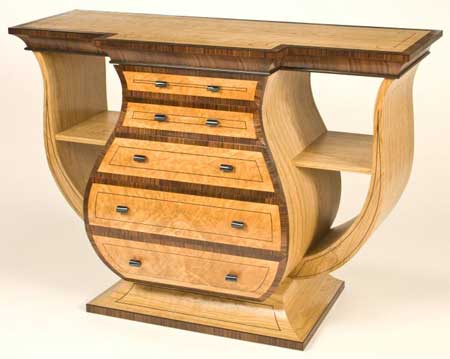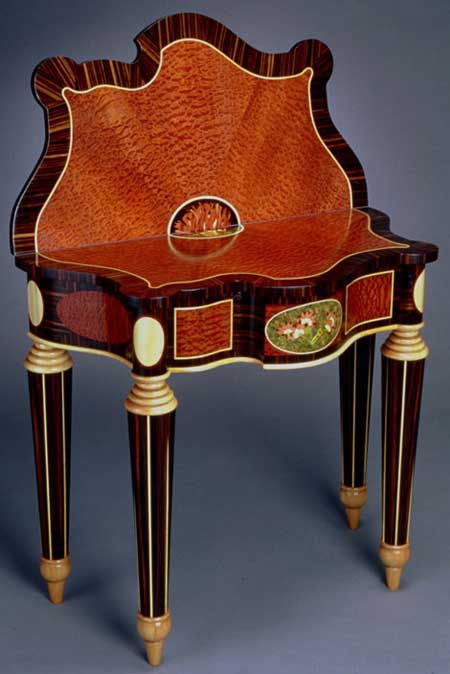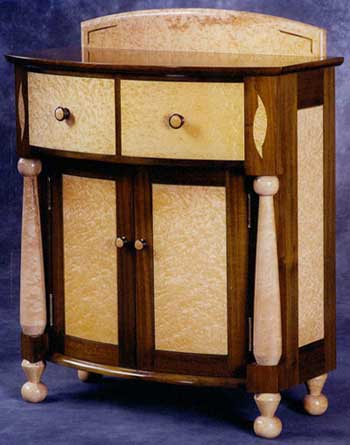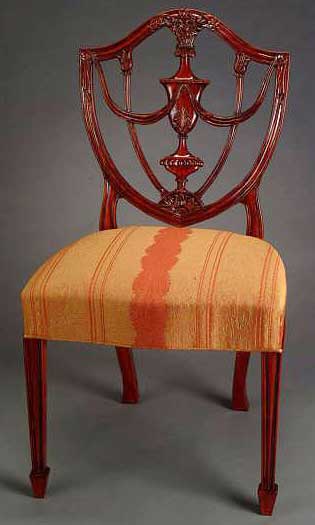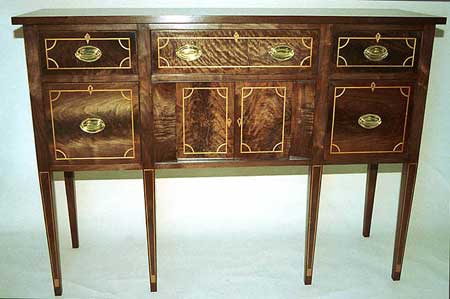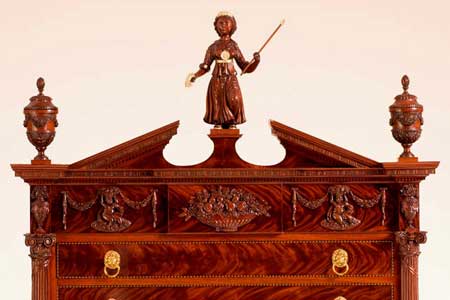
The recipient of the 2008 Cartouche Award from the Society of American Period Furnituremakers was Alfred Sharp. That statement alone speaks volumes to those who know how prestigious that award is, and the quality of work for which it is awarded. Most consider it the highest honor a furniture maker can get. What’s more interesting, though, at least in my mind, is uncovering the layers of experience that get someone to that elevated state. To that end, I had a nice long chat with Alf Sharp, and it was as delightful as it was informative.
“Shortly after dropping out of law school in 1970,” Alf recounted, “I started doing carpentry because I needed to do something to make a living. Law school, and my first white collar job, convinced me that I was not interested in the coat and tie world. I found myself very adept at carpentry, and that caused me to start looking at everything made of wood in a different light. That, in turn, quickly led to a desire to make furniture.
“Back then, there were almost no modern books or magazines on woodworking, so I found old textbooks and catalogs and started practicing everything I read. When I found an old woodworker who knew something, I pestered him until he told me to go away. If someone asked me if I could do something I said I could, then set about learning how to do it. In a sense, I was too stubborn to realize that I was never going to make any money at this, so I kept at it.
“Fortunately, the house we were living in at the time had a small shop building behind it. I bought a radial arm saw and learned to use every feature on it. Not long after, my family and I got an opportunity to move to the country. I set up a woodworking shop and started working seriously at it. I’d take whatever job came along, from making signs to building children’s playground equipment.
“Now and then, a good commission would come along, but because those jobs were rare, I also started doing production work. Before long I had 25 employees in 15,000 square feet, building dimensioned stock and basic furniture parts. I was utterly miserable, because as the business owner, I was once again in a white collar job. What made it worse was that I sometimes had to pass on the sort of challenging work I wanted to do because of the pace of the factory work. I sold the business the first chance I got, and built a small shop in my house in 1981. After selling the factory, I managed to fall back into happy obscurity.
“Over the ensuing years, I’ve done both furniture and architectural work for The Hermitage, Andrew Jackson’s home, for the Tennessee State Capitol building, and for every governor of Tennessee since 1984. That helped my word-of-mouth reputation, and more quality commissions started coming along.
“In 2006, I built what I would consider my magnum opus: a reproduction of a chest on chest that is in the Museum of Fine Arts in Boston. The original was done by Samuel McIntyre in Salem, Massachusetts in 1790. On top there is a carved figure of Nike, the goddess of victory. Because of the current association with the term, it was almost tempting to outfit her with a pair of running shoes, but I resisted. She is flanked by two urns festooned with garlands, and stands above drawers carved with a basket of fruit and flowers, with putti, or cherubs, on either side. The hardware is gilt brass. All told, it took about a year of full-time work to build.
“One of my most recent pieces is a lyre-shaped sideboard inspired by a Biedermeier secretary. I don’t do much speculative work, but this one was on spec, built for an exhibition traveling across Tennessee. It’s made of cherry, laurel and ebony, with pulls of handblown glass.
“Another spec piece, which I still own, is a flip-top card table. I had been asked by Wilsonart® to do something with their plastic laminate. I did the piece rather tongue-in-cheek, but liked it enough that I rebuilt in real veneers. I exaggerated the proportions of Federal Sheraton style card table, threw in an asymmetrical top, and along with sycamore, used lush Art Deco woods like sapele and Macassar ebony.
“Recently, along with a fellow woodworker, I started a new project, and with it a new business called Stones River Hardwoods. For the past 25 years, I’ve been buying extra special lumber from a local gentleman, more or less a hobby saw mill operator. He let me know that he was getting old enough to get out of the business, and I bought his inventory. It’s over 100,000 board feet of some of the most beautiful Appalachian hardwoods, including walnut, cherry, maple, oak, sassafras, poplar and Eastern red cedar. Much of it is in oversize and thick slabs, making it perfect for things like traditional reproduction work.
“One of the things I have loved about this activity, and what kept it alive for me, is that there is no end to what you can learn, and no upper limit to the skills you can develop. In theory, you could continue to progress in your skills through several lifetimes.”
That’s an interesting comment coming from a woodworker who has already progressed so much in just one lifetime.
